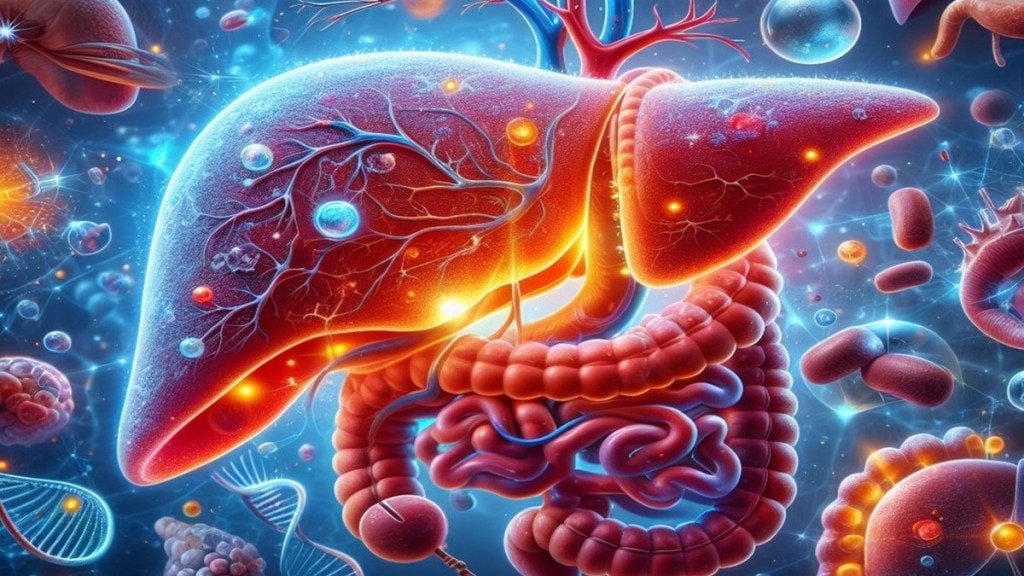Fatty liver disease, medically known as hepatic steatosis, is emerging as a major public health concern, particularly in India. With sedentary lifestyles, poor dietary habits, and increasing obesity rates, cases of fatty liver have surged dramatically. While often considered harmless in its early stages, the condition can silently progress to severe liver damage, including fibrosis, cirrhosis, and even liver failure.
Understanding when a fatty liver becomes dangerous is crucial for early intervention, effective management, and preventing life-threatening complications, Dr. Piyush Kumar Sinha, Consultant – Liver Transplant and HPB Surgery, Manipal Hospital Dwarka, New Delhi told Financial Express.com.
What is Fatty Liver?
Fatty liver disease occurs when excess fat gets deposited in the liver due to reasons other than alcohol. It can be classified into two types:
- Non-Alcoholic Fatty Liver: Simple fatty liver without much inflammation or liver cell damage.
- Non-Alcoholic Steatohepatitis (NASH): Fatty liver with inflammation and damage, which may progress to cirrhosis and liver cancer.
Worldwide, 1 billion people are affected. In India, 18-20% of the population is overweight, and 9-32% of the general population has fatty liver. Additionally, 2-5% of adults and up to 20% of those who are obese may develop NASH.
How Fatty Liver Impacts Health?
In the early stages, fatty liver may be asymptomatic, with most people unaware they have it. However, continued fat buildup leads to inflammation and fibrosis, which can impair liver function. The liver has a great reserve capacity, so symptoms generally appear only when less than 20% of functioning liver remain. Symptoms may include fatigue, swelling of limbs, jaundice, and abdominal swelling etc.
The most significant event in the progression of fatty liver disease is the development of fibrosis. Those who develop fibrosis have a high incidence of progressing to cirrhosis and liver cancer. When cirrhosis sets in, the liver’s ability to conduct essential processes such as detoxification and nutrient regulation is severely impaired.
Can Fatty Liver Lead to Liver Failure?
Fatty liver may progress to liver failure, typically after passing through several stages. The stepwise progression is as follows:
- Simple Steatosis: Early fat deposition without significant inflammation or injury.
- NASH: Development of inflammation and cellular injury, predisposing to fibrosis and cirrhosis.
- Cirrhosis: Severe scarring, which can lead to complications such as ascites (fluid in the abdomen), jaundice, kidney dysfunction, blood vomiting, and encephalopathy (brain dysfunction).
- End-Stage Liver Disease/Hepatic Failure: Loss of essential hepatic functions, potentially requiring liver transplantation.
When Does Fatty Liver Become Dangerous?
Fatty liver becomes dangerous when it progresses to NASH, as this stage involves significant inflammation and liver damage. NASH can lead to fibrosis and, eventually, cirrhosis in a percentage of patients. Comorbid conditions like diabetes, obesity, and high blood pressure predispose individuals to more severe progression.
“As mentioned earlier, there are no clear signs or symptoms of NASH. Symptoms only appear once the liver disease has progressed to an irreversible stage,” Dr. Sinha said.
Why is Screening for Fatty Liver Disease Necessary?
Screening for fatty liver disease has recently been incorporated into national health programs. Since it is difficult to diagnose NASH without a liver biopsy, the strategy is to identify if fatty liver disease is present and determine who may be at risk of developing liver fibrosis. Early diagnosis, when the condition is reversible, allows for timely intervention. Screening also helps manage advanced liver disease effectively.
Furthermore, 70-90% of fatty liver disease patients have other components of metabolic syndrome, such as obesity, diabetes, hypertension, and hyperlipidemia, which are also identified during screening. The screening involves blood tests and abdominal ultrasound. Those at risk of fibrosis may undergo liver stiffness measurement.
What Can Be Done to Prevent Liver Failure?
Fatty liver disease is often reversible in its early stages with lifestyle changes. The most important measures are:
- Weight loss: Losing 10% of body weight can significantly reduce hepatic fat and inflammation.
- Dietary changes: Following a diet rich in fruits, vegetables, whole grains, and lean proteins, while avoiding saturated fats and sugars, helps safeguard liver health.
- Regular exercise: Exercise can reduce hepatic fat and improve metabolic function.
- Control of comorbidities: Managing diabetes, hypertension, and hyperlipidemia reduces the risk of disease progression.
“Fatty liver is an emerging health problem in India, caused by lifestyle factors and metabolic disorders. Although initially asymptomatic, it can progress to NASH, cirrhosis, and eventually liver failure, which is highly dangerous. Early detection and active management, especially through lifestyle modifications, are essential to prevent severe liver damage. In advanced cases, liver transplantation may be required to manage the complications of fatty liver and restore liver function, ensuring better long-term health outcomes,” Dr. Sinha said.
